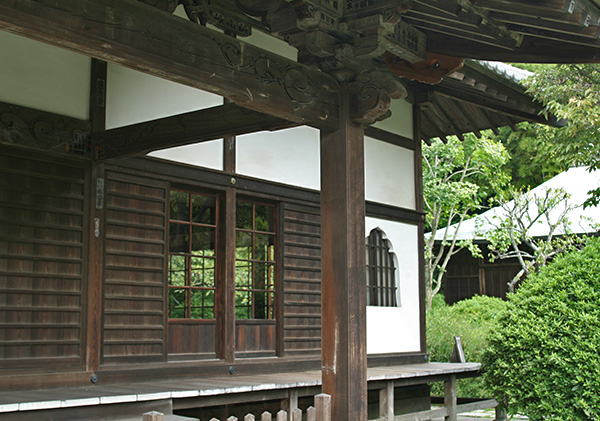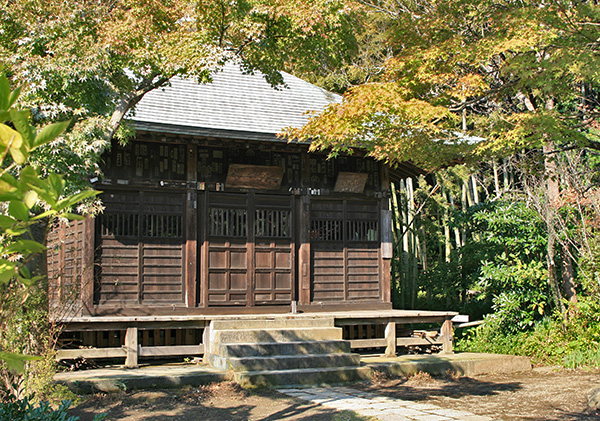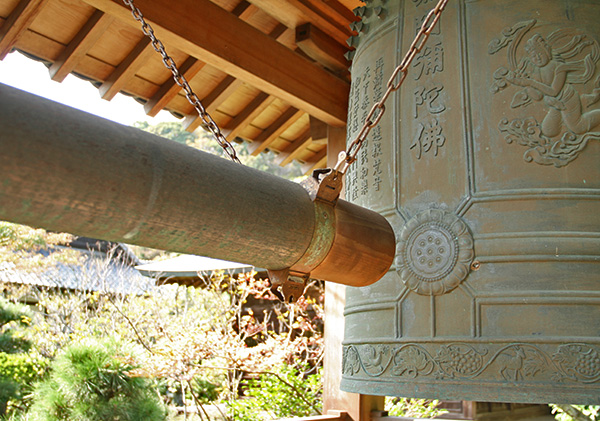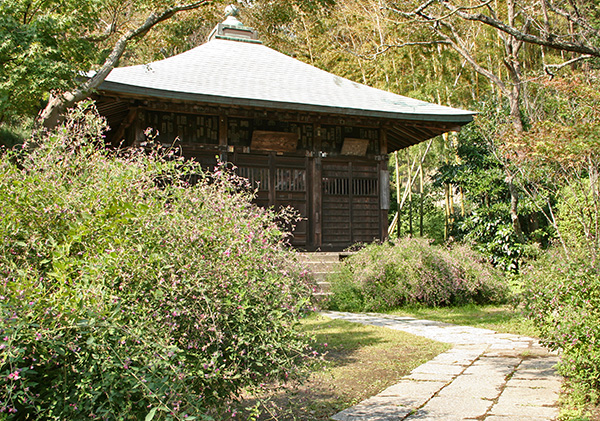Jokomyoji
| Official Name | Sengokuzan Jokomyoji {Pronounced sen-kok-zan joe-koh-myo-gee} |
|---|---|
| Religious sect | Sen'nyuji school (Kyoto), Shingon sect, Buddhism |
| Founded | in 1251 by Nagatoki Hojo {nah-gah-toh-key hoh-joe} |
| Founding priest | Shin-a {shin-ah} |
| Main object of worship | Statues of Amida {ah-me-dah} trinity |
| Address | 12-1 Ogigayatsu 2-chome, Kamakura, Kanagawa 248-0011 (show route from current location ) |
| Location | 1,000 meters north of Kamakura Station |
| Time needed to get there | 15 minutes |
| Admission | 300 yen for Amida hall and backyard |
| Open | 10:00-12:00 and 13:00-16:00 on Thursday, weekends and holidays, weather permitting |
| Phone number | 0467-22-1359 |
| Restrooms | Available |
Historical Overview
Founder Nagatoki Hojo (1230-1264) briefly assumed the post of the Sixth Hojo Regent. The Temple was built while he was stationed in Kyoto as a chief commander of the military headquarters called Rokuhara Tandai {rok-ha-rah tan-dye}. He came back to Kamakura in 1252 accompanying Prince Munetaka {moo-neh-tah-kah} at the time the Prince was coming down as the Sixth Shogun. As soon as Nagatoki handed over the Regency to Masamura {mah-sah-moo-rah} Hojo (1205-1273) in 1264, he took Buddhist vows under the name of Sen-a {sen-ah}, similar to that of founding priest, but died a month later. His ashes were naturally buried here.
When the Kamakura Shogunate collapsed and Emperor Godaigo {go-dye-go} (1288-1339) restored the supremacy in 1333, the Temple was selected as the one for the imperial family. Takauji Ashikaga {tah-kah-woo-gee ah-she-kah-gah} (1305-1358), the founder of the Muromachi Shogunate, was a good patron for the fourth chief priest Chian {chee-an}, and helped the priest to remodel the Temple.
In 1335, Tokiyuki {toh-key-you-key} Hojo (?-1353), son of 14th Hojo Regent Takatoki Hojo (1303-1333), attacked Kamakura to retrieve the Hojo regime. Tadayoshi {tah-dah-yo-she} Ashikaga (1306-1352), younger brother of Takauji, was then in Kamakura and Takauji in Kyoto. Tadayoshi and his troops were on the brink of defeat right here in the Temple. To help guard his brother and Kamakura against the attack of Tokiyuki, Takauji and his army came back to Kamakura without getting an approval from the Imperial Court, which made Emperor Godaigo enraged. The Ashikagas won the battle eventually, and Tokiyuki was killed.
After the battle, Takauji confined himself in the Temple under the observation of Priest Chian to express his allegiance to Emperor Godaigo. Some literatures say, however, that during this confinement, he changed his mind to revolt against the Emperor. After all, he was a descendant of the Minamoto Family, and may have wanted to revive the Minamoto Shogunate. In the end, he won the battle against the Imperial army and established the Ashikaga Shogunate in Kyoto.
Contributing to the expansion of the Temple was Tadayoshi Ashikaga. Thanks to his dedication, it one time was a mainstay of Buddhism in Kamakura with more than ten sub-temples constructed. Even in the Muromachi Period (1336-1573), the Temple enjoyed Kamakura governors' patronage, and ashes of the first Kamakura Governor Motouji {mo-toh-woo-gee} Ashikaga (1330-1367) and the second Governor Ujimitsu {woo-gee-me-tsu} Ashikaga (1359-1398) were buried here.
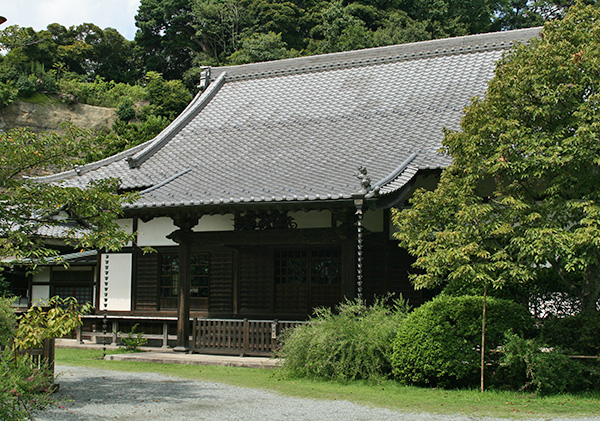
Amida {ah-me-dah} Hall
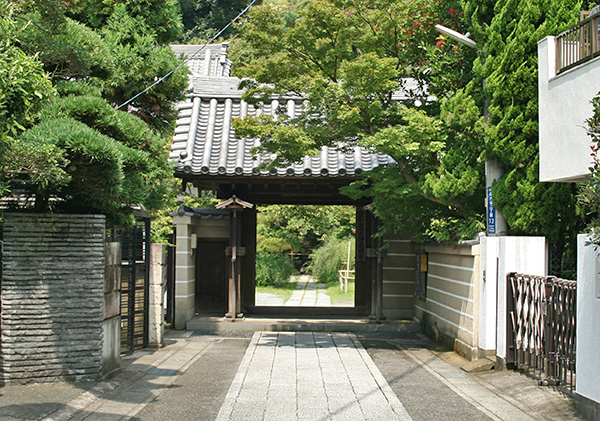
Between the Guest House and the Fudodo Hall is a path leading to the Main Hall. Up a flight of narrow stone steps is a receptionist booth and all visitors are requested to pay 200 yen here. Right in the middle of the courtyard is an old, wooden Main Hall facing south, which is also called Amida (Amitabha in Skt.) Hall since the statues of Amida Trinity used to rest in this hall before. As the appearance shows, it looks very old except the copper roof. It was rebuilt in 1668 in an architectural style of Zen Buddhism. Part of the pillars and beams were recycled from the ones used in Yofukuji {yoh-fook-gee}, gorgeous structures built by Yoritomo Minamoto, but no longer extant. The 5.4-meter-square building is an ICA designated by the Municipal Government. Enshrined inside the hall are statues of, from left to right, Amida Nyorai {nyo-rye}, or Amitabha representing the past, Shaka (Sakyamuni in Skt.) Nyorai, the present, and Miroku {me-roh-koo} (Maitreya in Skt.), the future. All statues are relatively new, though.
A statue of Nagatoki Hojo, the founder of the Temple, is installed in the right-hand recess and that of Shin-a (?-1296) in the left. Both were made during the Muromachi Period (1336-1573).
In front of the Main Hall are gigantic trees of podocarp or Podocarpus macrophylla, believed to be more than 750 years old.
Tombs for Tamesuke Reizei (1263-1328)
To the left-hand side of the cave is a flight of some 40 steps leading up to the top of a hill right behind the cave, where a 153.5-centimeter-high Hokyo-into {ho-kyo-in-toh} tomb for a famous tanka poet Tamesuke Reizei {tah-meh-soo-keh ray-zay} stands, who was a court noble in Kyoto. Shortly after his father died, a dispute occurred between him and his brother (by different mother) over the land inheritance. Tamesuke's mother Abutsuni {ah-boo-tsu-knee} came down to Kamakura in 1279 to file a lawsuit to the court on behalf of Tamesuke since he was only 13 years old. She was also a famous tanka poetess and wrote a travel book entitled "Izayoi Nikki" {e-zah-yo-e nik-key} (literally, dairy of the sixteenth night of the lunar month), sketching what she saw during the travel from Kyoto to Kamakura. Amazing may it sound, it took her only 14 days to walk nearly 500 kilometers. The book is highly esteemed even today as it vividly depicts people and their lifestyle back in the Kamakura Period.
Tamesuke later joined his mother in Kamakura. They won the case eventually, but never returned to Kyoto. Because of this dispute, theTanka family was broken up to three schools changing the original family name of Fujiwara to Reizei, Kyogoku {kyo-goh-koo} and Nijo {nee-joe}. The present Reizei family have its residence in Kyoto. Tamesuke made tanka anthologies and contributed to the diffusion of tanka culture in eastern Japan. The Hokyo-into was built in the early Edo Period (1600-1868) by Mitsukuni Tokugawa {me-tsu-koo-nee toh-koo-gah-wah} (1628-1700), an offspring of Ieyasu Tokugawa, the founder of Tokugawa Shogunate. Some historians insist, however, that it must have been made in the 14th century as its appearance reveals, and Mitsukuni may have repaired it. Anyhow, it is designated as a Historic Spot by the National Government.
A great deal of precious documents kept by the Reizei family had remained unopened for 800 years by imperial order until 1980. In 1981 after the order expired, the family established the Reizei Museum in Kyoto exhibiting those ancient artifacts and documents, which include 20,000 items of literary materials, many of them aretanka poet.
Incidentally, the current head of the family is Tamesuke's descendant in 25th generation.
